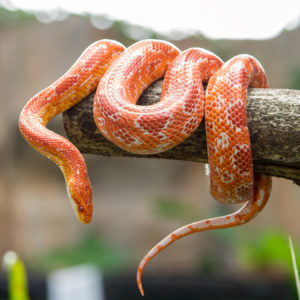Corn Snake

Scientific Name: Pantherophis Guttatus
Status: Least Concern (LC)
The corn snake (Pantherophis guttatus) is a North American species of rat snake that subdues its small prey by constriction. It is found throughout the southeastern and central United States. Though superficially resembling the venomous copperhead and often killed as a result of this mistaken identity, corn snakes lack functional venom and are harmless. Corn snakes are beneficial to humans by helping to control populations of wild rodent pests that damage crops and spread disease.
Habitat: Forest, Savanna, Shrubland, Grassland, Wetlands (inland), Caves and Subterranean Habitats (non-aquatic). mostly semi-fossorial, inhabiting in a wide variety of environments, from dry to humid, including pine forest, grass flatwoods, grasslands, open rock areas, and tropical hammocks.
Animal Location: Terrific Trails
Diet: The diet is primarily plant materials, including stems, leaves, tubers, fruits and seeds.
Reproduction: The species is generally monogamous. It builds a shallow nest of vegetation, lined with down and feathers, on ground, frequently near waterbodies. Clutches are usually four to seven eggs.


